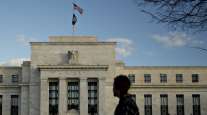US Payrolls Rise 213,000; Wage Gains Slow, Unemployment Up

U.S. hiring topped forecasts in June while unemployment rose from an 18-year low and wage gains unexpectedly slowed, indicating the labor market has room to keep expanding.
Nonfarm payrolls climbed 213,000 after an upwardly revised 244,000 advance, Labor Department figures showed July 6. The median estimate of analysts surveyed by Bloomberg News called for a gain of 195,000 jobs. Average hourly earnings rose 0.2% from the prior month — less than forecasts for the second straight 0.3% gain — while the jobless rate increased to 4% from 3.8%, the first rise in almost a year.
Treasury yields and the dollar fell while stock futures rose after the report, which suggested less pressure on the Federal Reserve to step up its pace of interest-rate increases, with the jobless rate already below central bank estimates of levels sustainable in the long run. Even so, a steady pace of hiring and gradually rising wages, along with lower taxes, are helping underpin consumer spending and propelling a rebound in U.S. growth.
While the sunny outlook led Fed officials last month to boost the number of interest-rate hikes they expect in 2018 to four from three, an intensifying trade war threatens to sap economic momentum, and a shrinking pool of qualified workers may slow the pace of employment gains.
“This is a good job-creation number, but on the other hand we see still continued soft wage growth,” said Michael Feroli, chief U.S. economist at JPMorgan Chase & Co. “It’s positive in the sense that we still have some capacity to grow above trend without triggering too much inflation worry.”
At the same time, the latest report “probably places less pressure on the Fed to feel like they’re behind the curve,” Feroli said. “It’s probably relieving for the Fed.”
Hanging over the labor market are President Donald Trump’s tariffs on goods from some of America’s largest trading partners, along with retaliatory charges. Levies on $34 billion in Chinese goods took effect at 12:01 a.m. Washington time on July 6. Economists say the effects could include companies curtailing both hiring and investment, which would have a cooling effect on the jobs figures in coming months.
Revisions to prior reports added a total of 37,000 jobs to payrolls in the previous two months, according to the figures, resulting in a three-month average of 211,000. In general, monthly payroll gains of around 100,000 — or even a bit less — are sufficient to keep pushing down the unemployment rate, according to economists.
Factory Jobs
The details across industries showed continued strength in goods-producing jobs: Manufacturing added 36,000 to payrolls, the best month since December, including a 12,000 increase in the auto industry, the most since August. That’s consistent with other reports showing strength in factory activity.
Service providers boosted payrolls by 149,000, led by a 54,000 gain in education and health services, and 50,000 in professional and business services. The retail industry’s woes were also reflected in employment, as vendors cut 21,600 positions, the biggest drop since December. That followed a 25,100 gain in May.
Several measures showed that the labor market still has slack to absorb.
The number of employed people in the workforce rose by 102,000, while the number of unemployed jumped by 499,000, suggesting more people entered the labor force and actively sought jobs. The participation rate, or share of working-age people in the labor force, increased to 62.9% from 62.7% the prior month.
The participation rate remains a closely watched measure for central bankers. While improving prospects for employment and wages are helping attract people from the sidelines of the job market, the retirements of older workers are among factors that have been exerting downward pressure on participation.
The employment-population ratio, another broad measure of labor- market health, was unchanged at 60.4%.
Despite a relatively tight labor market, wage growth remains stuck in the 2% range, with the annual gain of 2.7% unchanged from May. A separate measure, average hourly earnings for production and non-supervisory workers, also increased 2.7% from a year earlier, unchanged from the prior month’s gain. The average work week for all private employees was unchanged at 34.5 hours.
Other Details
•The U-6 or underemployment rate rose to 7.8% from 7.6%; the gauge includes part-time workers who’d prefer a full-time position and people who want a job but aren’t actively looking.
•People working part-time for economic reasons fell by 205,000 to 4.74 million.
•Private employment rose by 202,000 (median estimate 190,000) after increasing 239,000; government payrolls rose by 11,000, most since August.
•Black unemployment rate rose to 6.5% from record low of 5.9%; Hispanic rate fell to record low of 4.6%.
With assistance by Chris Middleton, Sophie Caronello, and Sho Chandra




